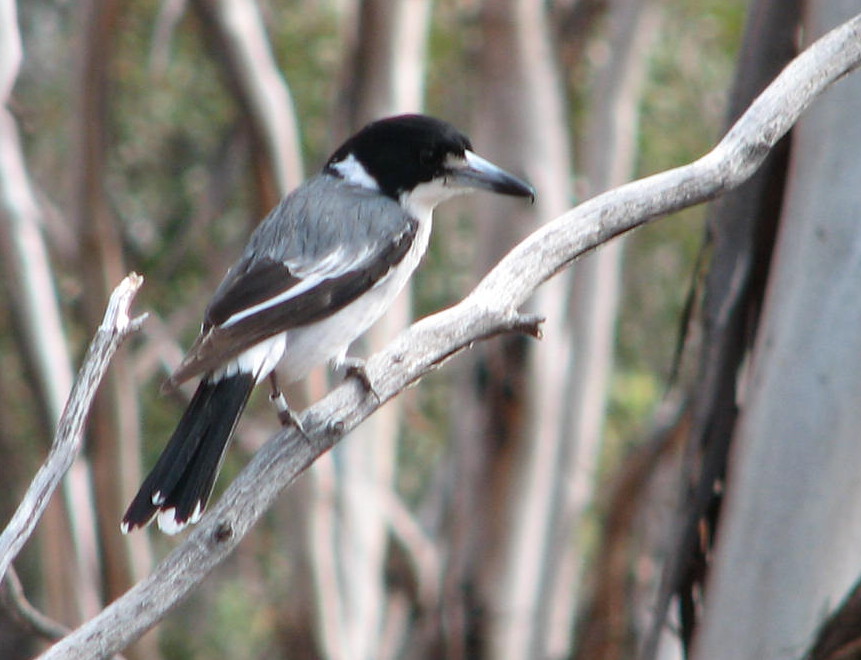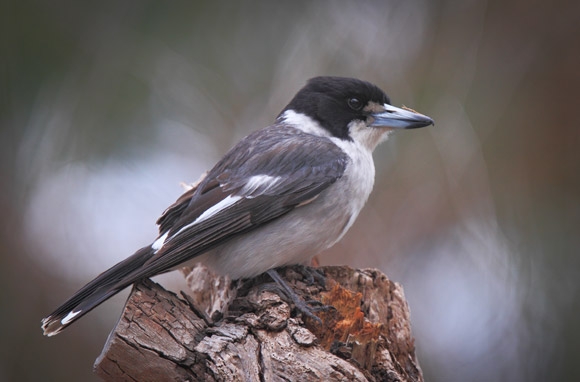
Cracticus torquatus
SUBFAMILY
Cracticinae
TAXONOMY
Lanius torquatus Latham, 1802, Port Jackson (Sydney), Australia.
Three, possibly four subspecies; one large and dark with
reduced white in wing in Tasmania (Cracticus torquatus
cinereus), another small and dark with reduced white in wing in
coastal southeastern Australia between the New South Wales-
Queensland border and Melbourne (nominate torquatus), and a
third (that may comprise east and west forms) small and paler
with extensive white in wing throughout southern and inland
Australia from the west coast to coastal Queensland south of
Cape York Peninsula (C. t. leucopterus). The gray butcherbird
forms a superspecies with the silver-backed butcherbird (C. argenteus)
of northwestern Australia and the black-backed
butcherbird (C. mentalis) of Cape York Peninsula and dry sectors
of southeastern New Guinea.
OTHER COMMON NAMES
French: Cassican а collier; German: Graurьcken-Wьrgatzel;
Spanish: Pбjaro Matarife Gris.
PHYSICAL CHARACTERISTICS
10–12 in (25–30 cm); 2.8–4.0 oz (80–110 g). Medium-sized
bull-headed bird with tapered body and black-, gray-, and
white-patterned plumage. Head black with white lore spot (between
eye and upper bill) and collar, back gray, rump white,
tail and wings black with white tips and stripes respectively,
and undersurface uniformly grayish white. Eyes dark brown,
feet gray, and bills bicolored, with black tip and gray-white
base. Females are usually grayer breasted and shorter billed
than males. Juveniles dull-gray-billed and dully patterned, with
dusky-olive and speckled upperparts and yellowish underparts.
DISTRIBUTION
Most of southern and inland Australia north to 20°S, including
Tasmania but excluding treeless deserts.
HABITAT
Closed woodland and open forest of eucalypts and acacias, including
mallee (Eucalyptus) and mulga (Acacia) scrubs, where
the space between tree crowns is about the size of the crowns
themselves. Densities range from one bird to about 12 to 49
acres (5–20 ha) in suitable habitat.
BEHAVIOR
Retiring and solitary, in pairs or small family groups, gray
butcherbirds live in the mid- and upper strata of trees, spending
much of their time perching still and coming to ground
only to pounce on prey. They are sedentary, with pairs holding
the same territory, 20–99 acres (8–40 ha), year-round, with a
larger home range. Both male and female duet antiphonally in
songs of fluted whistles and ringing caws, which are also given
in alarm and aggression.
FEEDING ECOLOGY AND DIET
Gray butcherbirds are raptorial perch-pouncers, watching from
tree perches at 6.5–40 ft (2–12 m) up, then swooping down to
ground or branches to snap up prey, which is mostly insects
but also small birds, nestlings, reptiles, and mice. Fruit also
contributes to the diet. Food is carried back to perch, wedged
in crannies or forks and torn apart with the bill for eating; the
small weak feet are not used for tethering prey.
REPRODUCTIVE BIOLOGY
Monogamous, forming pair bonds in breeding territories reinforced
by much duetting during early breeding. Gray
butcherbirds breed mostly between July and August and December
and January throughout their range. The nest, a
rough but tight cup of twigs lined with finer, often reddish
fiber, is placed in upright forks in outer foliage at 10–50 ft
(3–15 m) up and takes about four weeks to build. Eggs, in
clutches of three to five, are 1.20–1.25 x 0.85–0.95 in (30–32
x 22–24 mm), brownish green, and finely freckled in redbrowns,
often in a zone around the larger end; they hatch in
22–24 days. Female builds nest and incubates unaided, while
the male defends territory. He may assist her in feeding
young, which fledge around four weeks. Usually, only one
brood reared per year.
CONSERVATION STATUS
Not threatened, although many populations have declined locally
because of habitat clearing and alienation.
SIGNIFICANCE TO HUMANS
Some local populations frequent camping sites, feeding on
scraps and garbage thrown out by campers. They are called
commensals in such circumstances because they benefit from a
close association with humans.
Photo Gallery of - Gray butcherbird




 Animalia Life
Animalia Life